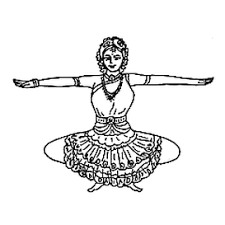Bharatanatyam is a pre-eminent Indian classical dance form that originated in the Hindu temples of Tamil Nadu and eventually became a mainstream dance form. It is regarded as the mother of many other Indian classical dance forms. Conventionally a solo dance performed only by women, it initiated in the Hindu temples of Tamil Nadu and eventually flourished in South India. Bharatanatyam is known for its grace, elegance, and intricate footwork. The dance form is characterized by precise movements, sharp edges, and expressive body language.
Bharatanatyam costumes are an essential part of the dance form, reflecting the rich cultural heritage of the dance. The style of dressing of a Bharatanatyam dancer is more or less similar to that of a Tamil Hindu bride. The costume consists of a cloth specially stitched in pleats that falls in the front from the waist and when the dancer performs spectacular movements, the pleats open up like a lotus in bloom. The costume is usually made of silk, with intricate designs and patterns that add to the overall aesthetic appeal of the performance.
The costume is complemented by jewelry, which is an essential part of the Bharatanatyam costume. The jewelry includes a headpiece, earrings, necklaces, bangles, and anklets. The jewelry is made of gold, silver, or other metals and is often studded with precious stones. The jewelry adds to the overall aesthetic appeal of the performance and complements the movements of the dancer.
The makeup of a Bharatanatyam dancer is also an essential part of the costume. The makeup is usually heavy, with bold colors and intricate designs. The makeup is designed to enhance the facial expressions of the dancer and to complement the overall aesthetic appeal of the performance.
The costume of a Bharatanatyam dancer is not only about the clothing but also about the accessories. Accessories such as jewelry, hats, and masks can add to the overall aesthetic appeal of the performance. They can also help to establish the style and atmosphere of the dance.
The history of Bharatanatyam costumes is as old as the dance itself. In ancient times, dance costumes were made of animal skins, leaves, and flowers. As dance evolved, so did the costumes. In the 19th century, Bharatanatyam costumes became more elaborate, with dancers wearing silk sarees, jewelry, and makeup.
Bharatanatyam costumes are designed to harmonize with the dance and not hinder the movements of the dancer. They are created to be comfortable, flexible, and durable to endure the wear and tear of dancing. They are also designed to be visually appealing, reflecting the culture, tradition, and style of the dance form.
The costume of a Bharatanatyam dancer is a reflection of the rich cultural heritage of the dance form. The intricate designs and patterns on the costume are a testament to the skill and craftsmanship of the artisans who create them. The jewelry, makeup, and accessories complement the costume and add to the overall aesthetic appeal of the performance.
In conclusion, Bharatanatyam costumes are an essential part of the dance form, reflecting the rich cultural heritage of the dance. The costume consists of a cloth specially stitched in pleats that falls in the front from the waist and when the dancer performs spectacular movements, the pleats open up like a lotus in bloom. The costume is usually made of silk, with intricate designs and patterns that add to the overall aesthetic appeal of the performance. The jewelry, makeup, and accessories complement the costume and add to the overall aesthetic appeal of the performance. The art of Bharatanatyam is enhanced through the clothing, and costumes are designed to harmonize with the dance and not hinder the movements of the dancer.




